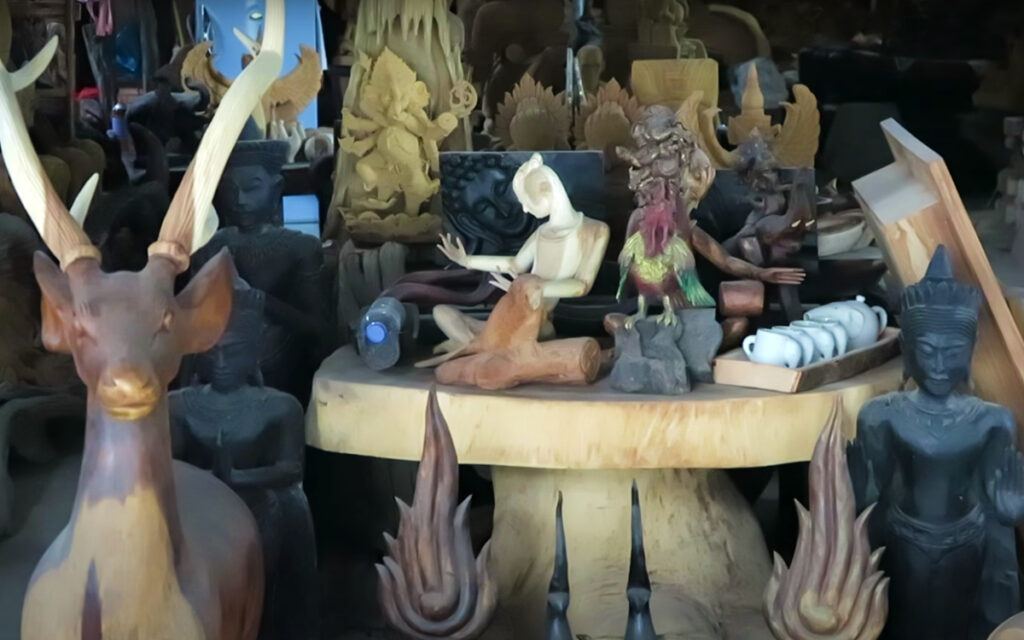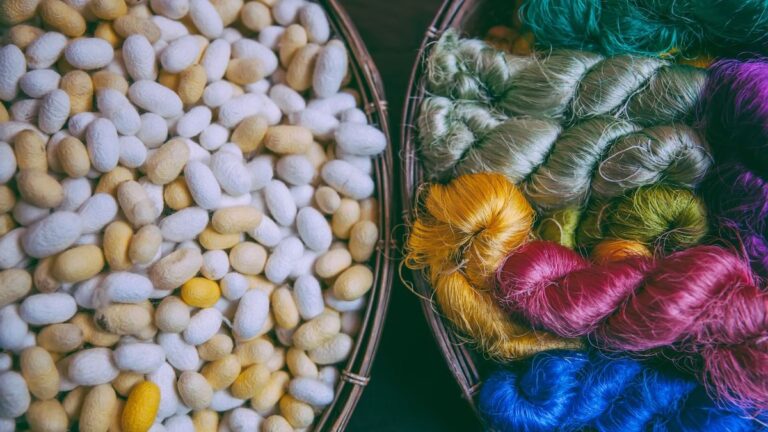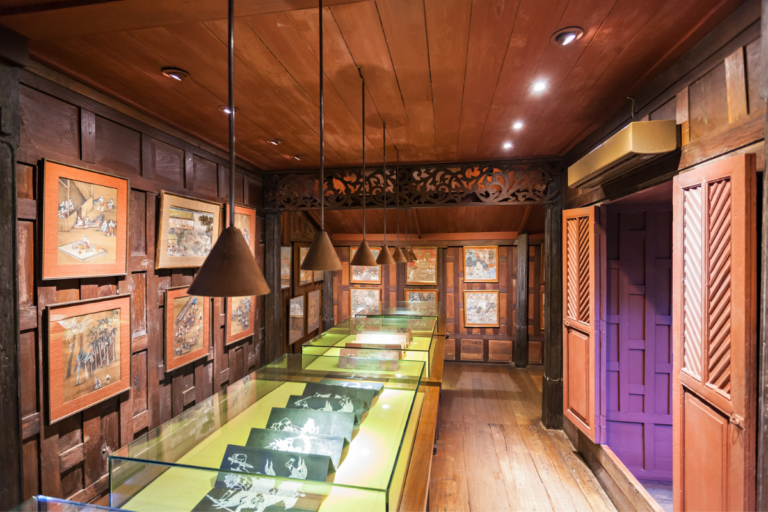Arts and Crafts of Thailand
Handicrafts are a signature product of Thailand that is difficult to resist buying as souvenirs while visiting. Arts and crafts of Thailand are inexpensive, unique, and make excellent gifts. Handicrafts represent a skill that is deeply ingrained in Thai culture, and preserved by the tourist trade. Within Thailand, most handicrafts are produced in different parts of the northern region, ranging from small family-owned operations to larger industrial work groups.
Each district offers various types of Thai handicrafts; high-quality goods are usually found in the region where they are made. For the best handicraft shopping experience, visitors should head to the catch-all destination of Chiang Mai from Bangkok and other parts of the country.
Where to Look for Thai Handicrafts
Chiang Mai’s Night Bazaar and Sunday Walking Street markets are teeming with handicrafts, housewares, handmade musical instruments, and artists’ booths. These vibrant, open-air markets are fast-paced and confusing at times; and the quality of similar handicrafts can vary as much as the price when shopping as a tourist. But everywhere you go in Thailand, where tourists are found you’ll invariably come across street stalls selling everything from wooden kids’ toys to souvenir items and home décor.
If you’re shopping for Thai handicrafts of higher quality and don’t mind paying a little extra, then you’ll probably want to head away from the main tourist markets and seek out a non-profit outlet whose revenue goes directly to the creators, encouraging higher quality work. Shopping through these organizations keeps revenue in the hands of the artisans.
 Hang Dong
Hang Dong
A few miles southwest of Chiang Mai is Hang Dong, Thailand’s pre-eminent center for wooden handcrafts and furniture shopping. Shops in this area have large showrooms with more space to display their goods. In addition to endless arrays of furniture, you’ll also find attractive wicker woven baskets, lacquerware boxes, and sculptures. San Kamphaeng is another popular shopping district near Chiang Mai with shops spanning the whole gamut of Thai handicrafts.
Shopping enthusiasts are lured by taxi and tuk-tuk drivers into touring large factories on the outskirts of Chiang Mai. Generally, drivers receive a commission for delivering tourists and this extra fee will be recycled back into the cost of the goods. With this in mind, taking a tour of a handicraft factory may be an enlightening experience, but it doesn’t afford any real savings.
Night Market in Chiang Mai
The best prices when shopping for Thai handicrafts come from local shop owners who have long-standing business ties with local artisans and receive business by virtue of their location rather than with the help of a tout. The Sunday Night Market in Chiang Mai is an excellent place to shop for quality Thai handicrafts directly from local craftspeople, but obviously going directly to the manufacturers in Hang Dong is cheaper.
History of Art in Thailand
Delve into the unique, unforgettable world of Thai arts and crafts, steeped in centuries of intricate cultural history. As Buddhism is a major influence, the use of Buddha imagery in sculptures is common. The Sukhothai (1238–1438) and Ayutthaya (1531–1767) periods were especially pivotal in shaping the Thai traditional art style, which drew inspiration from other Asian countries like China.
Travel back in time to the Copper Period (2,500 years ago), when copper was a preferred medium for numerous household wares, jewelry, necklaces, rings, and bracelets. Then, fast forward to the Alloy Period (2,000 years ago), where crafts and artworks were composed of a striking copper and tin blend – the most well-known of which is a world-renowned large bronze drum found in an apple field by a farmer in 1988.
Finally, we arrive at the Iron Period (1,700 years ago), an era when Buddha statues, pottery, and iron products flourished, including the impressive gilt copper alloy statue of a monk exhibited at the Los Angeles County Museum of Art. Fall in love with the rich history of Thai arts and crafts, and discover the beauty of the intricate works created throughout time.
Popular Types of Thailand Handicrafts
Hilltribe artifacts are a popular craft and can be purchased literally all over the north of Thailand, usually from ethnic minority women decked out in traditional garb and speaking virtually no English. The quality of these items depends on where you’re shopping. The best hill-tribe artifacts can be purchased through non-profit organizations that charge a little more for the products and in turn solicit more authentic and high-quality handicrafts.
 Other popular items to consider on your shopping list include:
Other popular items to consider on your shopping list include:
- Buddhist art and sculptures
- lamps and home décor
- art and wall decorations
- rattan furniture
- wooden products (e.g. fruit bowls)
- nielloware (etched pewter)
- lacquerware
- kids toys
- apparel and clothing
- shoes
- leatherware
- ceramics
- soaps and essential oils
- silk garments and products
- bags and purses
- ornaments
- saa (mulberry) paper and products
The larger items, usually sold out of proper shops can be competently shipped home for you.
Thai Antiques Shopping Guide
Shopping for antiques in Thailand has become such a popular activity among tourists that there are very few authentic antiques remaining for sale. The few legitimate Thai antiques out there are generally very expensive and, in many cases, they’ve been acquired illegally. Shopping for authentic antiques in Thailand requires a keen eye and a lot of bureaucracy.
All the same, Thailand is on the frontlines of antique dealing in Southeast Asia, with prices much lower than in the rival markets of Singapore and Hong Kong. The best deals on antiques are found in the north, especially in Chiang Mai near the old city. Those who aren’t real collectors and prefer the aesthetics to the genuine article will find dozens of shops selling replicas and reproductions of Thai antiques. They look suitably impressive but are much more affordable.
Where to Look for Antiquest in Thailand?
Shoppers used to the Chiang Mai markets are prone to sticker shock when shopping for antiques in Bangkok, where you’ll pay considerably more for the same caliber of the merchandise. The primary places to buy in Bangkok are in River City, Chatuchak Market, Wag Burapha, Chinatown, Charoen Krung Road, and Nakorn Kasem. There are also several genuine dealers in Chiang Mai who present shopping customers with both genuine articles of various vintage, as well as very good reproductions.
No matter where you’re hunting, you won’t find a fire sale on Thai antiques. Each item is carefully appraised and dealers are generally aware of the value of their stock. Perusing a Thai antiques shop is worthwhile even for those who don’t intend to buy. The contents range from artifacts from temples to lacquerware, marionettes, tapestries, and ceramics.
Beware of Fakes and Regulations
Due to the high level of interest in shopping for Thai antiques, local dealers have had considerable success with replicas and (in some of the most malicious cases) outright fakes. The quality and attention to detail in these replicas make them desirable in themselves. The majority of those shopping for antiques in Thailand are actually more interested in what they look like rather than what they are worth. You needn’t be a deep-pocketed expert to go Thai antiques shopping here.
In many cases, Thai antique shoppers choose to purchase these faked antiques as a more conscientious tribute to ancient Thailand. Artisans go to great lengths to make these items as authentic and realistic as possible, and the final product is very believable. Only an expert Thai antique shopper would know the difference.
Collectors out to purchase authentic antique items in Thailand should be aware of a few regulations. All Thai antiques have to have prior approval before being exported, and permits can be obtained from the Fine Arts Department of the National Museum – usually arranged by the dealer upon sale. Bear in mind that many items are illegally smuggled in from Burma or Laos, so you need to make a conscientious decision on that.
The same requirements apply to any image of the Buddha, and customs officials enforce these requirements dutifully. This strict enforcement is for good reason, as Thailand has suffered a significant cultural loss in the past at the hands of carefree exporters concerned more with turning a profit than with cultural heritage.



